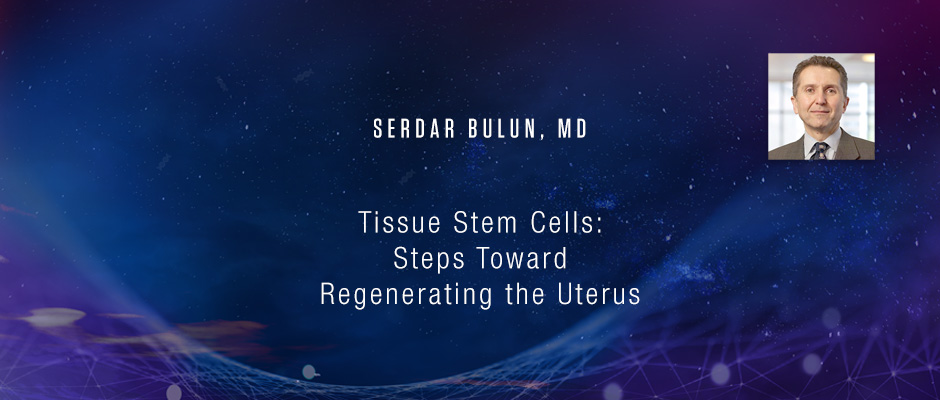Serdar Bulun, MD, Tissue Stem Cells: Steps Toward Regenerating the Uterus
Endometriosis Foundation of America
Medical Conference 2019
Targeting Inflammation:
From Biomarkers to Precision Surgery
March 8-9, 2019 - Lenox Hill Hospital, NYC
https://www.endofound.org/medicalconference/2019
Thank you very much. It's an honor to be here, and I will like to thank Dr. Seckin and Endo Foundation for inviting me to this wonderful conference, and also it's very meaningful that today is International Women's Day, and Happy Women's Day, everybody. I want to get started with ... I know I'm going to speak about endometriosis, but we've done a pretty good job in our lab to define the functions of stem cells or progenitor cells in uterine fibroids.
Basically, we demonstrated this concept that when you look at this entire tumor, what you see is 95 to 99% of this bulk is made of these terminally differentiated cells, and they die off. The real action is here in the stem cells. Although they make one to 5% of this entire bog, they are the ones who proliferate and renew, but they lack progesterone receptors. So, progesterone acts on these differentiated cells. They send signals like RANKL and Wnt, and that makes these stem cells a nurturer. As a result, the entire tumor grows in a symbiotic way.
We successfully targeted these signaling pathways, for example, to show that this could be exploited. I just want to put this picture out there. This is a peritoneal endometriosis rectovaginal nodule. As you can see, most of these lesions are made of primarily endometrial stromal cells. There's some epithelium in some of them. Here, there is no epithelium. It's mostly blood containing macrophages and stromal cells and tons of fibrosis, and we demonstrated that these stromal cells are the culprit of inflammation, the major pathology in endometriosis.
Tamer gave this picture to me, and I think he showed this picture. Again, it's very compelling that retrograde menstruation. This picture was taken at the time of menstruation of a woman. It's quite compelling that retrograde menstruation and the travel of these cells back here play a role. In fact, until today, I was agnostic when I first started investigating endometriosis. But it turned out that all of our molecular findings show that retrograde menstruation probably counts for more than 95% cases of pelvic endometriosis.
Then these three papers came one after the other. This Chinese paper from Lee, and paper in the New England Journal of Medicine, and finally, this Suda paper from a Japanese group. What these people showed is that boarding eutopic endometrium and in endometriotic lesions and in ovarian cancer, all of these epithelial cells contain the same mutations: KRAS, PIK3CA, and ARID1A. It's very interesting. It's very compelling.
We hypothesized that maybe the mutagenesis can happen because of inflammation and estradiol. I also want to emphasize here that when you look at endometriosis, the mutations occur in the epithelial cells, right? These groups also, they sequenced the stromal cells. There are no mutations in stromal cells. So we've been working on stromal cells for 25 years. What happens in stromal cells is there are tons of epigenetic abnormalities, problems with DNA programming.
As a result, these abnormal transcription factors come up, and then these abnormal transcription factors give rise to prostaglandin formation that caused pain, tons of estrogen formation. So, it's important to recognize that, yeah, these cells, from the uterus, epithelial and stromal cells go back in almost all women. In 10% of them, they cause these symptoms. If they go to the ovary, now, there is evidence that because they are the identical ovarian cancer driver mutations, they are involved in ovarian cancer.
But although it was a negative finding, it was extraordinarily important. [Shi-en 00:05:45] Tamez, New England Journal of Medicine paper showed that if they end up in the rectovaginal nodule, they don't cause cancer. So there must be an environment conducive to cancer in the ovary. In fact, I wrote an article about this in endocrinology recently, and one of the reviewers said, "I want you to speculate." They sent a reviewer back. They said, "This is too lame. I want you to speculate. What do you really think?"
I said, "Fine." So we think that estradiol is the culprit because there's tons of estradiol in the ovary, maybe majored in 10,000 picograms per mL, and estradiol could be converted to catechol estrogens or quinones that go directly to DNA and depurinate DNA and cause accumulation of more mutations. So, really, usually, one mutation doesn't cause cancer. You really have to accumulate a lot of mutations. This is pure speculation, by the way. I don't think anybody showed this.
There're a lot of studies in breast cancer, but not in ovarian cancer, right? Actually, I look for partners from this group. Maybe we can get together and study some of this stuff. Hugh has done a lot of valuable work in endometrial stem cells. He's going to talk about cells that come from the bone marrow. A lot of progenitors, local stem cell work has been done arguably by Caroline Gargett from Australia. Carolyn thinks that these stromal cells, the mesenchymal cells that accumulate around the blood vessels, may serve as these progenitor cells that make the next endometrium and the next cycle.
Then these cells exist, again, both in the functional and basalis. Probably there are more of these in the basalis. I mean, sometimes, the thing speaks for itself. I mean, there's nothing left other than basalis and maybe some islands or functional as Larry suggested. But these cells might ... These tissues must have something to do with rebuilding the endometrium even if they incorporate some other's bone marrow cells. I think this was a Leyendecker hypothesis, and he never wrote it somewhere.
But it makes sense. If the separation occurs at a more superficial level, less number of maybe stem-like cells would be carried to the peritoneal cavity. On the other hand, if it occurs at a deeper level, it may. I mean, this shows that a lot of cellular defects may cause the same phenotype. You can argue that maybe vascular cells could be the culprit. So epigenetics is everything about DNA programming is about the stem cells, and one-off epigenetic regulation is how these CpG islands on DNA is methylated or unmethylated.
We demonstrated that this is totally abnormal or different in endometriotic stromal cells compared with endometrial stromal cells in that the distribution of methylated or unmethylated CpG islands in endometriosis if they are functional, reside primarily in open seas. That means in the intergenic regions, uncharted territories between the genes. Still, this was not well understood. We published it some time ago. We demonstrated that two genes that are alternatively methylated came up two transcription factors: GATA-2 and GATA-6.
To simplify things, GATA-6 is a good transcription factor that helps normal endometrium to decidualize properly. GATA-6 is the bad one that causes a lot of inflammation, and we were interested more about this. What we did was we went ahead and chartered the entire genome. So, in the genome, like there are three billion base pairs, right? And 25,000 some genes in the human genome. So, these charts represent how GATA-2 binds to the entire genome around these 25,000 genes. It looks like the green normal endometrium, GATA-2 binding is much stronger whereas it's much weaker in endometriosis.
On the other hand, we see the ... I want to show one more thing for this retrograde menstruation hypothesis. I think this supports it. This yellow stuff is eutopic endometrium from patients with endometriosis. As you can see, this is genome-wide, not a single gene. It falls in between. So, it shows that there's something wrong with the eutopic endometrium of patients with endometriosis. This GATA-6, and again, it's really prominence in the genes upregulated in endometriosis. It binds more avidly.
And less avidly in both in normal endometrium and eutopic endometrium from patients with endometriosis. So, that relationship is not so clear here. This is how if we put it all together, it sounds like there's another level of complexity. These are the histones. So, there is DNA methylation, right? Then there are the histones around which the DNA is like organized. There are certain residues on these histones that are methylated or acetylated. It looks like in normal endometrium, there's a GATA-2 binding dominance and for the genes upregulated in normal endometrium, also the enhancer type of histone modifications are promoted.
In endometriosis, exactly the opposite takes place. GATA-6 is more prominent, and endometrial type genes are suppressed whereas GATA-6 causes the activation of more proinflammatory genes. And again, we are going to come back to this concept just a little bit when we talk about stem cells, just a little bit. When we overexpress GATA-6 in normal endometrium, when we ectopically express it, it shows that it changes the phenotype of normal endometrium to a more inflammatory type by overexpressing these 30 genes from the immunome, which over-represents the upregulated genes.
I think Tamer invited me to talk a little bit about this subject mostly, human iPS cells, induced pluripotent stem cells. In 2006 or a little bit earlier, Yamanaka who's a Nobel laureate now, who's an orthopedic surgeon, showed that if you add four simple genes, overexpress them in any cell, like you can make a skin biopsy, or you can get a bone marrow biopsy and simply add four genes, four transcription factors. This erases the entire DNA programming, that epigenetic programming, and make them pluripotent stem cells, which are called iPS cells.
A lot of investigators, they weren't very successful to differentiate them into cardiac cells or lung cells or liver cells. But they could never be differentiated into the endometrial type cells, so that was our contribution. The story is, like back to your embryology classes in medical school, iPS cells are like embryonic stem cells. They could be differentiated into primitive streak and intermediate mesoderm earlier. Then they would differentiate into kidney cells, but people never were able to follow the other line to differentiate them into endometrium, through coelomic epithelium, to müllerian ducts, to endometrium.
So what we did was we applied this Wnt/beta-catenin enhancer together with some of the other factors. First, to take intermediate mesodermal cells that originated from iPS cells and differentiated them to coelomic epithelium, apparent by these key markers like PDGF receptor and TCF21 and some of the others. As you can see, both at the mRNA and protein level. The next step was to turn coelomic epithelium to müllerian duct, which was a big deal from day six to day eight. And again, we demonstrated this by showing these markers. But the punchline was I think we all wanted to see HOXA10 and HOXA11 right here, of course.
That's important.
And the progesterone receptors. So, I think that was the key. I don't think people were able to differentiate these cells ever to a cell type that express a steroid receptor, and we managed to do that. So there was like a prominent, respectable expression of progesterone receptor. Once we use this ... Now, we added a AZA treatment, which is a DNMT inhibitor together with E2, and this cure compound is the key. So it inhibits GSK3 beta, which activates beta catenin. We all know that Wnt system is very important for uterine development.
As you can see, very respectively, we demonstrated both PRB and PRA both by [wesins 00:18:17]. Also, we demonstrated HOXA11 protein and PR protein. These are all nuclear by the way. Finally, I think this is the last data slide that I'm going to show is we decidualized these cells. So we used the time [inaudible 00:18:41] decidualization hormonal cocktail made off estrogen, medroxyprogesterone acetate, and the cyclic AMP analog. So, now we are on day 14. We treated them for eight days, and in each one, we use two clones of human cells. These are like XX46XX iPS cells.
As you can see, like at least in this clone, IGAPP1, which is the ultimate marker for decidualization, went up by 1,000 fold. In this one, it was almost like 100 fold. So there was some difference between the clones, and FOXO1, prolactin receptor, these all were ... We demonstrated IGAPP1 by [anilyza 00:19:39]. So, again, I mean, we are talking about probably the technology that will be developed over the next 20, 30 years, because iPS cells were intended to use to cure human disease. The earlier trials were started in Japan I guess in honor of Dr. Yamanaka in macular degeneration.
They made retinal cells from a different patient and put it in a different subject and put it in the patients suffering from macular degeneration. It was complicated by a change of law in Japan, and also I think right now they start to see some problems. So, by any means, this is not perfect yet. But we can use our imaginations just a little bit, and we need that for endometriosis. So defective endometrial stromal cells contribute to uterine factor infertility, endometriosis, and endometrial cancer.
And again, for example, grade one endometrial cancer and has a lot of stromal cells, right? If you treat these patients with progestins, as gynecologists, we all know that they respond. Once you get to grade three endometrial cancer, they are like sheets of epithelial cells. They don't respond to progesterone. Why? Because there are no stromal cells that contain progesterone receptors. So you can use this technology for that purpose too.
Replacement of abnormal stromal cells with normal ones could be a potential and novel therapeutic approach. Of course, we have to use our imaginations how we're going to do this. Again, we can reprogram them by these factors: Induced pluripotency, use differentiation factors to appropriately make them progesterone, responsive, and put them back. Thank you so much for your attention.










